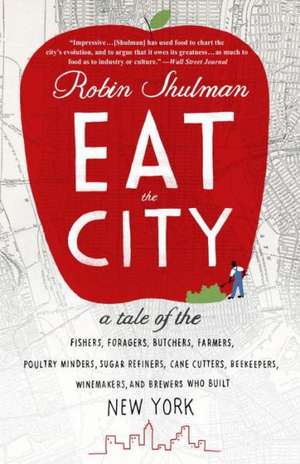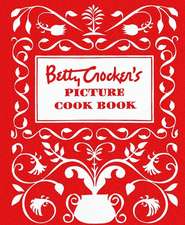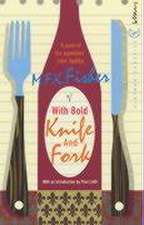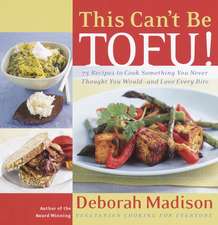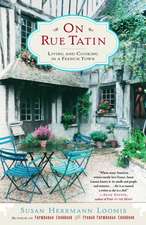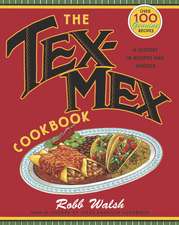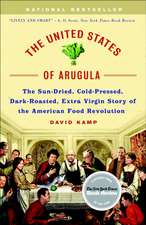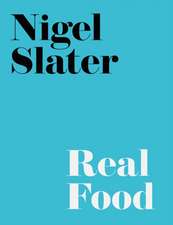Eat the City: A Tale of the Fishers, Trappers, Hunters, Foragers, Slaughterers, Butchers, Poultry Minders, Sugar Refiners, Cane Cutt
Autor Robin Shulmanen Limba Engleză Paperback – 20 mai 2013
Food, of course, is about hunger—but it's also about community. With humor and insight, Eat the City shows how, in places like New York, people have always found ways to use their collective hunger to build their own kind of city.
Preț: 123.68 lei
Nou
Puncte Express: 186
Preț estimativ în valută:
23.67€ • 25.72$ • 19.90£
23.67€ • 25.72$ • 19.90£
Carte disponibilă
Livrare economică 31 martie-14 aprilie
Preluare comenzi: 021 569.72.76
Specificații
ISBN-13: 9780307719065
ISBN-10: 0307719065
Pagini: 335
Dimensiuni: 130 x 201 x 23 mm
Greutate: 0.27 kg
Editura: BROADWAY BOOKS
ISBN-10: 0307719065
Pagini: 335
Dimensiuni: 130 x 201 x 23 mm
Greutate: 0.27 kg
Editura: BROADWAY BOOKS
Notă biografică
ROBIN SHULMAN is a writer and reporter whose work has appeared in the New York Times, the Washington Post, the Los Angeles Times, Slate, the Guardian, and many other publications. She lives in New York City.
Extras
1
HONEY
Sundays in the summer, Andrew Cote likes to hive hop, collecting honey. Sometimes he takes the subway from his apartment on the Lower East Side, his smoker and his bag of hive tools banging against his thigh as he walks. But mostly he drives a white Toyota Tundra pickup abuzz with bees hovering over the truck bed, where their honey has been stashed. They will travel with the truck for hours, from one borough to another, seeking to reclaim what is theirs in a scene out of an urban Winnie-the-Pooh.
Andrew curses his way through traffic, flips one-handed through a giant ring for keys to the next rooftop hive building, and parks wherever he can find a space.
Much of city beekeeping is vertical work. Up a narrow stairway in the dingy darkness, carrying tools to hives on a roof in the shadow of the Brooklyn Bridge. Down six flights of stairs from rooftop hives on a different building on Second Avenue, balancing heavy, oozing frames of honey.
Back outside, truck full of honey, when someone pauses and stares at the buzzing bees still lingering above the truck, Andrew says, “We’re out of here,” and guns the motor. When a cruiser slows down and a cop yells out the window, “Is that honey?” Andrew cheerfully calls, “Legal since April 2010! Want to try?”
While hobbyist beekeepers usually maintain just a hive or two, Andrew practices a particularly muscular brand of urban beekeeping, managing forty hives on rooftops, terraces, and balconies, and in yards and gardens in Manhattan, Brooklyn, and Queens. A fourth-generation beekeeper, Andrew is a kind of honey lord with a petty honey fiefdom, supervising a network of hundreds of novices he has taught and mentored in the city. He sells boxlike hives he makes himself, along with packages of bees as starter kits. At the New York City Beekeepers Association that he helped launch, he presides over monthly meetings, which routinely draw the illuminati of the beekeeping world--great beekeepers, authors of books on honey, artists focused on bees.
To hear Andrew tell it, honey-making is a hustle. It’s nothing like producing wine or cheese, where you mix careful quantities of ingredients together, monitor temperatures and chemical processes, and tend a thing while it becomes something else. In beekeeping, your job is observation, fraud, and theft. You set up conditions (a good clean hive, water, a supply of nearby flowers) so the bees feel equipped to plan for the future. Sooner or later, your bees will fly forth and suck nectar from flowers, spit in enzymes that thicken and preserve it, and construct cells of wax in which to store it as food for the long winter. Driven by instinct that looks like artisanal zeal, they will use their tiny wings as fans to cool the wax in summer and warm it in fall. Many die. You, on the other hand, just pry open the lid of the hive, which the bees, perhaps foreseeing such crimes, have sealed shut with a sappy glue they extract from plants. You knock out the bees with a dose of smoke and seize their waxen provisions. And then you’re out, with nary a sting. You’ve got honey.
Of course, Andrew will tell you that in cities, beekeeping is more complicated. You’ve got to find a place to install a hive--perhaps some unused roof or flower-filled community garden--and lobby co-op boards and garden members to approve. You’ve got to make arrangements for access at least once every few weeks. You’ve got to carry around heavy protective clothing to keep from getting stung--many times--as a single bee stinging emits a scent that alerts other bees to join the attack.
In a crowded city, you have to work especially hard to prevent a swarm, a hive reproduction technique whereby half the bees in a colony fly off to find a new home and cluster for hours or maybe days in some tree--or, in the case of New York, one of many treelike structures, such as a traffic light or a street sign in front of the Bulgari jewelry store on Fifth Avenue. It looks like the stuff of horror films: a ball of 30,000 bees flying through the air making a noise like a buzz saw, Andrew will say. People get scared. Nearby businesses can’t operate, and crowds gather to stare. A beekeeper can head this off by dividing the hive in two when it’s particularly populous and active--but the timing has to be right. In case of error, Andrew and other experienced beekeepers set up a swarm hotline where anyone can leave a voice message that gets sent as a text alert to phones including Andrew’s. He will grab his beekeeping gear and rush over. Like a hooded superhero on a utility ladder, he will trap the swarm and spirit the bees away to a new hive.
New York City outlawed beekeeping in 1999, and for a decade afterward, a clandestine apiarist culture survived despite the risk of a $2,000 fine for an illicit hive. People put up screens and walls and grew foliage to hide the hives in their gardens. On rooftops, they painted hives gray to look like air conditioning units, or red, like chimneys. After removing frames of honey, they wrapped them in garbage bags and sealed them with duct tape before carrying them, quietly buzzing, into public view. They hosted underground honey tastings and sold their wares in boutique groceries. At most, there were a few dozen beekeepers in the city, and the hobby seemed to attract lone eccentrics, such as a Brooklyn drag performer who sold honey under his female alias, and a man in the Bronx who lived in a rectory and had learned beekeeping from a Trappist monk. Finally when beekeeping became legal again in 2010, new beekeepers emerged in force.
Often they’re in it for the honey. City honey is an edible record of available nectar in the urban landscape, and a discerning palate can see and taste the distinctive flavors of different neighborhoods. A complex and nuanced South Bronx honey comes from bees feasting on flora at the nearby botanical garden. A Manhattan East Village honey, pale with a minty taste from bees working the linden trees, has hints of apple, peach, and rose, from the many community gardens. A Prospect Heights, Brooklyn, honey is heavy from the Echinacea flowers of a local garden and from Prospect Park itself. In some neighborhoods, the honey is so sweet, it’s overwhelming: sharp, almost acid. In others, it is light, high, citrusy, and tangy. Elsewhere it’s musky and indistinct--or nutty, spicy, with a bitter aftertaste. Hives near one another generally produce similarly flavored honeys, so that if you were to map a particular city’s honey flavors, you would see gradually shifting regions determined by prominent nearby flowers. It’s even easier to track the changing flavors of honey throughout the season as various flowers bloom and fade. Early honey, from clover and the spring-flowering trees, is light in color and flavor, and the later stuff from goldenrod in the fall has a deep hue with a heavy taste.
Some newer beekeepers have been moved to the hobby by tales of colony collapse disorder, the name for a phenomenon in which whole colonies of bees disappear. The cause has not yet been fully determined, but studies point toward systemic pesticides. Farmers and commercial beekeepers, whose bees pollinate agricultural crops, began to talk about a dearth of pollinators to produce fruits and vegetables across the country. Urban bees were less affected, and some city people began to tend their own hive in hopes that they could somehow bolster the species. A sense of crisis in beekeeping peaked just as New York City legalized the practice. Interest soared.
Urban beekeepers all over the country do what Andrew does: They are swarm wranglers, bee dealers, hive inspectors, club leaders, beekeeping teachers, honey sellers. But most major cities that allow beekeeping have a long-standing institution with a stable community to manage problems. In Chicago, a nonprofit cooperative contracts with City Hall to manage the hives on its roof. In San Francisco and Seattle, volunteer organizations have collected swarms for decades. But in New York, all this is new, and Andrew Cote is often the one to educate, mediate, and trap wayward bees. The recent legalization of urban beekeeping unleashed a wave of pent‑up interest from aspiring beekeepers, fans of bees, and the media. These days, Andrew often works with a pack of acolytes in tow, a microphone clipped to his T‑shirt and a lens trained on his face.
Andrew’s own group for hobbyist beekeepers, the New York City Beekeepers Association, grew to 300 active members in just a few years following legalization. He alone trained 320 people in beekeeping in two years, while a competing beekeeping meet‑up group trained another 400. Perhaps New York has become the city with the most interest in urban beekeeping in the history of beekeeping in American cities. But bees are wild creatures that cannot be tamed, and that can create unforeseen problems--interpersonal problems that require diplomacy not generally associated with keepers of honeybees. Problems that are, so to speak, sticky.
At thirty-nine years old, Andrew is fit, strong, and tightly strung. He’s classically handsome enough that a modeling scout signed him up while he was working at his market honey stand, and he ended up starring in a Goldman Sachs ad. He has a flirtatious sparkle in his eye, a quick grin, a quicker wit, a handy touch, a low tolerance for error, and moods that shift as quickly and totally as a sudden storm. He has worked as a community college professor of English but also spent time in Iraq. He doesn’t like to talk about what he did there, but he came back in 2006 with post-traumatic stress disorder and Monday-afternoon appointments with a shrink. Now he seems to lack the self-corrective feature that makes human interaction bearable. He can be incredibly dedicated: When a bus hit his cargo van last spring while he was delivering bees, the bloodied Andrew, covered in broken glass and lying on a gurney by an ambulance, phoned other beekeepers to come pick up their packages. Yet he also punches people when he’s mad. He tears up when he’s sad. He writes vengeful emails to strangers. Fellow beekeeper David Selig says, “He’s like an angry bee.”
One late-summer day in 2009, David Selig--shirtless, barefoot, hot--stepped out onto the deck off his bedroom, climbed a utility ladder up to the roof, coffee mug in hand, and tiptoed across the scalding silver surface to visit his bees. He had already collected early honey from two hives he had installed on his roof in the spring: It had been a pale tawny color, strained of all flavor but a newborn sweetness, like the first clover blossoms. But now, as he settled with his coffee, squatting near the entrance of the hive, he noticed something strange. The foragers flying back from gathering nectar were glowing in the late-afternoon light, incandescent, as though lit up by an internal red bulb.
Something unusual had clearly affected his bees. David is a calm person: He’s thoughtful, low-voiced, he is not rash. He finished his coffee, noting the disconcerting beauty of his red bees in the sun, like living, moving warning lights. Then he stepped back down the ladder and went inside to Google “red bees.” The search turned up nothing much--Red Bee comics, Red Bee crafts, Red Bee Media. When he went back to the roof to check the hives, the bees no longer looked red, the honeycomb seemed fine, and he chose to assume that whatever had been amiss, had passed.
David was in love with honey. Not just the sweetness, but the way it connects you with the place where you are, since bees, collecting nectar and pollen from flowers, skim what they need from any environment and transform it into something you can taste. When he traveled to Syria, Turkey, and Jamaica, he would taste the honey, seek out beekeepers, and find that often, through their bees, they noticed changes in botany and climate, industry and agriculture, that others did not. “I enjoy observing nature,” David would say when he got stung and his skin swelled and reddened with a rush of blood. Bees had first fascinated him when he was a child helping to keep them during summers at his grandparents’ farm in Ontario, Canada. More recently, David, a restaurateur with chains of successful eateries, had opened a kind of honey bar for wholesalers where people could sample single-varietal honeys on wooden blocks, such as wild lavender honey from Provence, fragrant and incredibly light and dry on the tongue. Ultimately, he sold the place after it was featured in a magazine and he was flooded with hundreds of orders a day. “Honey doesn’t pour quickly,” he said. “We just couldn’t even keep up with orders.”
When he finally decided to buy his own house with his girlfriend, it seemed natural to ask Andrew Cote to provide materials for two white wood-frame hives for David to install on the rooftop.
David didn’t see a red bee again until the next year, during his second summer in the house, when day after day the thermometer edged over 90 degrees. Beekeeping had just become legal, and others with new hives in the neighborhood were worried about the heat. David’s girlfriend, Cecilia Dean, a fashion muse and editor of an avant-garde magazine, parked herself under the ceiling fan, the dog, Mott, lolled with his tongue out, the two cats barely moved, and David went to check on his charges on the roof. He stepped through the threshold of Cecilia’s museum-like walk‑in closet--packed with vintage Helmut Lang and Martin Margiela suits, custom-made gifts from Karl Lagerfeld and Marc Jacobs, spiky stilettos from Nicholas Kirkwood and thigh-high boots from Balenciaga--and onto the deck. He climbed the ladder to the roof, and as he sat with his soy latte to enjoy watching the bees, he noticed that they were again glowing red.
He jammed scraps of wood and twine for burning into his beekeeper’s smoker, a metal device like a bellows that breathes a cool, pleasant-smelling smoke that has a calming effect on bees. Then he banged away at the propolis, the sticky substance the bees use to close up the hive. He pried off the lid with a flat-headed tool, directed the smoke toward the bees within, and pulled out a frame from inside. Reassuringly, it was heaving with honey. But the substance looked unusually dark. And when he held it up to the morning sun, he saw that the honey was an untrue, electric shade somewhere between fuchsia and scarlet. He pulled out frame after frame of the second hive, only to find the same. And there were his bees, flying back to their hives, bright red lights themselves, to efficiently deposit the neon nectars of their labors, leaving blazing droplets like so many scattered pomegranate seeds on the white wood.
“Then you freak out,” David said.
HONEY
Sundays in the summer, Andrew Cote likes to hive hop, collecting honey. Sometimes he takes the subway from his apartment on the Lower East Side, his smoker and his bag of hive tools banging against his thigh as he walks. But mostly he drives a white Toyota Tundra pickup abuzz with bees hovering over the truck bed, where their honey has been stashed. They will travel with the truck for hours, from one borough to another, seeking to reclaim what is theirs in a scene out of an urban Winnie-the-Pooh.
Andrew curses his way through traffic, flips one-handed through a giant ring for keys to the next rooftop hive building, and parks wherever he can find a space.
Much of city beekeeping is vertical work. Up a narrow stairway in the dingy darkness, carrying tools to hives on a roof in the shadow of the Brooklyn Bridge. Down six flights of stairs from rooftop hives on a different building on Second Avenue, balancing heavy, oozing frames of honey.
Back outside, truck full of honey, when someone pauses and stares at the buzzing bees still lingering above the truck, Andrew says, “We’re out of here,” and guns the motor. When a cruiser slows down and a cop yells out the window, “Is that honey?” Andrew cheerfully calls, “Legal since April 2010! Want to try?”
While hobbyist beekeepers usually maintain just a hive or two, Andrew practices a particularly muscular brand of urban beekeeping, managing forty hives on rooftops, terraces, and balconies, and in yards and gardens in Manhattan, Brooklyn, and Queens. A fourth-generation beekeeper, Andrew is a kind of honey lord with a petty honey fiefdom, supervising a network of hundreds of novices he has taught and mentored in the city. He sells boxlike hives he makes himself, along with packages of bees as starter kits. At the New York City Beekeepers Association that he helped launch, he presides over monthly meetings, which routinely draw the illuminati of the beekeeping world--great beekeepers, authors of books on honey, artists focused on bees.
To hear Andrew tell it, honey-making is a hustle. It’s nothing like producing wine or cheese, where you mix careful quantities of ingredients together, monitor temperatures and chemical processes, and tend a thing while it becomes something else. In beekeeping, your job is observation, fraud, and theft. You set up conditions (a good clean hive, water, a supply of nearby flowers) so the bees feel equipped to plan for the future. Sooner or later, your bees will fly forth and suck nectar from flowers, spit in enzymes that thicken and preserve it, and construct cells of wax in which to store it as food for the long winter. Driven by instinct that looks like artisanal zeal, they will use their tiny wings as fans to cool the wax in summer and warm it in fall. Many die. You, on the other hand, just pry open the lid of the hive, which the bees, perhaps foreseeing such crimes, have sealed shut with a sappy glue they extract from plants. You knock out the bees with a dose of smoke and seize their waxen provisions. And then you’re out, with nary a sting. You’ve got honey.
Of course, Andrew will tell you that in cities, beekeeping is more complicated. You’ve got to find a place to install a hive--perhaps some unused roof or flower-filled community garden--and lobby co-op boards and garden members to approve. You’ve got to make arrangements for access at least once every few weeks. You’ve got to carry around heavy protective clothing to keep from getting stung--many times--as a single bee stinging emits a scent that alerts other bees to join the attack.
In a crowded city, you have to work especially hard to prevent a swarm, a hive reproduction technique whereby half the bees in a colony fly off to find a new home and cluster for hours or maybe days in some tree--or, in the case of New York, one of many treelike structures, such as a traffic light or a street sign in front of the Bulgari jewelry store on Fifth Avenue. It looks like the stuff of horror films: a ball of 30,000 bees flying through the air making a noise like a buzz saw, Andrew will say. People get scared. Nearby businesses can’t operate, and crowds gather to stare. A beekeeper can head this off by dividing the hive in two when it’s particularly populous and active--but the timing has to be right. In case of error, Andrew and other experienced beekeepers set up a swarm hotline where anyone can leave a voice message that gets sent as a text alert to phones including Andrew’s. He will grab his beekeeping gear and rush over. Like a hooded superhero on a utility ladder, he will trap the swarm and spirit the bees away to a new hive.
New York City outlawed beekeeping in 1999, and for a decade afterward, a clandestine apiarist culture survived despite the risk of a $2,000 fine for an illicit hive. People put up screens and walls and grew foliage to hide the hives in their gardens. On rooftops, they painted hives gray to look like air conditioning units, or red, like chimneys. After removing frames of honey, they wrapped them in garbage bags and sealed them with duct tape before carrying them, quietly buzzing, into public view. They hosted underground honey tastings and sold their wares in boutique groceries. At most, there were a few dozen beekeepers in the city, and the hobby seemed to attract lone eccentrics, such as a Brooklyn drag performer who sold honey under his female alias, and a man in the Bronx who lived in a rectory and had learned beekeeping from a Trappist monk. Finally when beekeeping became legal again in 2010, new beekeepers emerged in force.
Often they’re in it for the honey. City honey is an edible record of available nectar in the urban landscape, and a discerning palate can see and taste the distinctive flavors of different neighborhoods. A complex and nuanced South Bronx honey comes from bees feasting on flora at the nearby botanical garden. A Manhattan East Village honey, pale with a minty taste from bees working the linden trees, has hints of apple, peach, and rose, from the many community gardens. A Prospect Heights, Brooklyn, honey is heavy from the Echinacea flowers of a local garden and from Prospect Park itself. In some neighborhoods, the honey is so sweet, it’s overwhelming: sharp, almost acid. In others, it is light, high, citrusy, and tangy. Elsewhere it’s musky and indistinct--or nutty, spicy, with a bitter aftertaste. Hives near one another generally produce similarly flavored honeys, so that if you were to map a particular city’s honey flavors, you would see gradually shifting regions determined by prominent nearby flowers. It’s even easier to track the changing flavors of honey throughout the season as various flowers bloom and fade. Early honey, from clover and the spring-flowering trees, is light in color and flavor, and the later stuff from goldenrod in the fall has a deep hue with a heavy taste.
Some newer beekeepers have been moved to the hobby by tales of colony collapse disorder, the name for a phenomenon in which whole colonies of bees disappear. The cause has not yet been fully determined, but studies point toward systemic pesticides. Farmers and commercial beekeepers, whose bees pollinate agricultural crops, began to talk about a dearth of pollinators to produce fruits and vegetables across the country. Urban bees were less affected, and some city people began to tend their own hive in hopes that they could somehow bolster the species. A sense of crisis in beekeeping peaked just as New York City legalized the practice. Interest soared.
Urban beekeepers all over the country do what Andrew does: They are swarm wranglers, bee dealers, hive inspectors, club leaders, beekeeping teachers, honey sellers. But most major cities that allow beekeeping have a long-standing institution with a stable community to manage problems. In Chicago, a nonprofit cooperative contracts with City Hall to manage the hives on its roof. In San Francisco and Seattle, volunteer organizations have collected swarms for decades. But in New York, all this is new, and Andrew Cote is often the one to educate, mediate, and trap wayward bees. The recent legalization of urban beekeeping unleashed a wave of pent‑up interest from aspiring beekeepers, fans of bees, and the media. These days, Andrew often works with a pack of acolytes in tow, a microphone clipped to his T‑shirt and a lens trained on his face.
Andrew’s own group for hobbyist beekeepers, the New York City Beekeepers Association, grew to 300 active members in just a few years following legalization. He alone trained 320 people in beekeeping in two years, while a competing beekeeping meet‑up group trained another 400. Perhaps New York has become the city with the most interest in urban beekeeping in the history of beekeeping in American cities. But bees are wild creatures that cannot be tamed, and that can create unforeseen problems--interpersonal problems that require diplomacy not generally associated with keepers of honeybees. Problems that are, so to speak, sticky.
At thirty-nine years old, Andrew is fit, strong, and tightly strung. He’s classically handsome enough that a modeling scout signed him up while he was working at his market honey stand, and he ended up starring in a Goldman Sachs ad. He has a flirtatious sparkle in his eye, a quick grin, a quicker wit, a handy touch, a low tolerance for error, and moods that shift as quickly and totally as a sudden storm. He has worked as a community college professor of English but also spent time in Iraq. He doesn’t like to talk about what he did there, but he came back in 2006 with post-traumatic stress disorder and Monday-afternoon appointments with a shrink. Now he seems to lack the self-corrective feature that makes human interaction bearable. He can be incredibly dedicated: When a bus hit his cargo van last spring while he was delivering bees, the bloodied Andrew, covered in broken glass and lying on a gurney by an ambulance, phoned other beekeepers to come pick up their packages. Yet he also punches people when he’s mad. He tears up when he’s sad. He writes vengeful emails to strangers. Fellow beekeeper David Selig says, “He’s like an angry bee.”
One late-summer day in 2009, David Selig--shirtless, barefoot, hot--stepped out onto the deck off his bedroom, climbed a utility ladder up to the roof, coffee mug in hand, and tiptoed across the scalding silver surface to visit his bees. He had already collected early honey from two hives he had installed on his roof in the spring: It had been a pale tawny color, strained of all flavor but a newborn sweetness, like the first clover blossoms. But now, as he settled with his coffee, squatting near the entrance of the hive, he noticed something strange. The foragers flying back from gathering nectar were glowing in the late-afternoon light, incandescent, as though lit up by an internal red bulb.
Something unusual had clearly affected his bees. David is a calm person: He’s thoughtful, low-voiced, he is not rash. He finished his coffee, noting the disconcerting beauty of his red bees in the sun, like living, moving warning lights. Then he stepped back down the ladder and went inside to Google “red bees.” The search turned up nothing much--Red Bee comics, Red Bee crafts, Red Bee Media. When he went back to the roof to check the hives, the bees no longer looked red, the honeycomb seemed fine, and he chose to assume that whatever had been amiss, had passed.
David was in love with honey. Not just the sweetness, but the way it connects you with the place where you are, since bees, collecting nectar and pollen from flowers, skim what they need from any environment and transform it into something you can taste. When he traveled to Syria, Turkey, and Jamaica, he would taste the honey, seek out beekeepers, and find that often, through their bees, they noticed changes in botany and climate, industry and agriculture, that others did not. “I enjoy observing nature,” David would say when he got stung and his skin swelled and reddened with a rush of blood. Bees had first fascinated him when he was a child helping to keep them during summers at his grandparents’ farm in Ontario, Canada. More recently, David, a restaurateur with chains of successful eateries, had opened a kind of honey bar for wholesalers where people could sample single-varietal honeys on wooden blocks, such as wild lavender honey from Provence, fragrant and incredibly light and dry on the tongue. Ultimately, he sold the place after it was featured in a magazine and he was flooded with hundreds of orders a day. “Honey doesn’t pour quickly,” he said. “We just couldn’t even keep up with orders.”
When he finally decided to buy his own house with his girlfriend, it seemed natural to ask Andrew Cote to provide materials for two white wood-frame hives for David to install on the rooftop.
David didn’t see a red bee again until the next year, during his second summer in the house, when day after day the thermometer edged over 90 degrees. Beekeeping had just become legal, and others with new hives in the neighborhood were worried about the heat. David’s girlfriend, Cecilia Dean, a fashion muse and editor of an avant-garde magazine, parked herself under the ceiling fan, the dog, Mott, lolled with his tongue out, the two cats barely moved, and David went to check on his charges on the roof. He stepped through the threshold of Cecilia’s museum-like walk‑in closet--packed with vintage Helmut Lang and Martin Margiela suits, custom-made gifts from Karl Lagerfeld and Marc Jacobs, spiky stilettos from Nicholas Kirkwood and thigh-high boots from Balenciaga--and onto the deck. He climbed the ladder to the roof, and as he sat with his soy latte to enjoy watching the bees, he noticed that they were again glowing red.
He jammed scraps of wood and twine for burning into his beekeeper’s smoker, a metal device like a bellows that breathes a cool, pleasant-smelling smoke that has a calming effect on bees. Then he banged away at the propolis, the sticky substance the bees use to close up the hive. He pried off the lid with a flat-headed tool, directed the smoke toward the bees within, and pulled out a frame from inside. Reassuringly, it was heaving with honey. But the substance looked unusually dark. And when he held it up to the morning sun, he saw that the honey was an untrue, electric shade somewhere between fuchsia and scarlet. He pulled out frame after frame of the second hive, only to find the same. And there were his bees, flying back to their hives, bright red lights themselves, to efficiently deposit the neon nectars of their labors, leaving blazing droplets like so many scattered pomegranate seeds on the white wood.
“Then you freak out,” David said.
Recenzii
"Chapters on honey, vegetables, meat, sugar and so forth follow present-day artisans and gardeners while exploring the past....[Shulman] found that even in the city, food producers are essential, connected parts of their communities."
—New York Times
"A buzzing, savory, lively world comes to life in Robin Shulman’s extensively researched 'Eat the City'...The book provides what’s missing from much of the breathless media coverage of New York’s modern food artisans: culinary context. Europeans who landed in what became New York Harbor found hillsides red with strawberries and 12-inch oysters in the waters? That’s history made delicious.”
—Washington Post
"The author has employed her skills as a writer and journalist to pull off a rather impressive feat: She has used food to chart the city's evolution, and to argue that it owes its greatness as an international crossroads, particularly in its early years, as much to food as to industry or culture...These days New York marks its greatness not so much by its industry or by the sweat of its brow, but as a center for finance and culture, and how much its penthouses fetch. However, amid its 90-story condos and three-star restaurants, we run the risk of forgetting on whose broad shoulders, and often punishing effort, we stand. That is, unless we read Ms. Shulman's book."
—The Wall Street Journal
“Straightforward, but not overly earnest, and smartly layered, this well-researched social history is organized in seven chapters ordered like the courses of a meal… [Shulman] is particularly good at illustrating how big a part food played in the city’s social history. From the sugar trade’s role in making Manhattan the largest slave port in the nation to the role of refrigeration in building distance between food sources and consumers, Shulman is adept at shifting our perspective on the foods we eat.”
—Boston Globe
“Robin Shulman's must-read new book Eat the City features insight about how food and beverage production moved from the urban landscape of New York City to the farms and beyond, only to come back to places like Brooklyn and Manhattan in the past few years. She tells fascinating stories, and hones in on some of the current scene's livelier personalities, like Brooklyn artist-butcher Tom Mylan.”
—Food Republic
“The author masterfully traces the wonderful spectrum of the city’s culinary geniuses going back a hundred years and moving into the present day to portray the men and women who bring select food to our tables.”
—New York Daily News
"In telling the stories of New Yorkers and our food through the centuries and looking to the future -- stories by people from all over the world who now call this city home -- Shulman serves her readers the nourishment of connection."
—Nicole Reed, Food Systems Network NYC
"Robin Shulman immerses herself in the heart of New York, finding hidden gardens, wineries, abattoirs, and apiaries in the most unexpected places. Through her personal stories, she convinces us that in order to live and eat in a city, we must understand where our food comes from and how it is made."
—Alice Waters
“Eat the City is about the men and women who came to New York City--now and in the past--and planted gardens, harvested honey, made cheese, and brewed beer and made New York what it is today. Robin Shulman uses their stories to bring this rich history to life and to reflect on the forces that brought immigrants and their food traditions to this city. Not all of these stories have happy endings, but they inform, move, and inspire.”
—Marion Nestle, professor of nutrition, food studies, and public health at New York University and author of What to Eat
"Robin Shulman introduces us to today's trendy fooderati, and then reveals--through careful historical research--that growing food in the city isn't so new after all."
—Novella Carpenter, author of Farm City
“Robin Shulman’s Eat the City locates a new point on the urban grid: the intersection of the man-made city and the abundance of the natural world. This overlooked New York is home to rows of corn, collards and okra in formerly burnt-out lots, shady rooftop vineyards, and Brooklyn honeybees fed on industrial nectar, courtesy of the local Maraschino cherry plant. Laced with surprises, Eat the City describes the human impulse to harness nature and turn it into food, even in the most unlikely surroundings.”
—Jane Ziegelman, author of 97 Orchard
With beautiful detail, Shulman tells the tale of a city, however rich or poor, that has always wanted to eat well. From a Harlem numbers house that lured gamblers with city-grown produce to a hipster butcher transforming a corner of Williamsburg, Eat the City reminds us that New York’s true foodies live in every corner, in every class, of every borough.
—Tracie McMillan, author of The American Way of Eating
“Shulman’s brilliant, transformative book weaves history, journalism, and storytelling into a secret atlas of New York… A profound, surprising, and exquisitely written exploration of how food and its makers, even in the unlikeliest places, keep all of us human.”
—Annia Ciezadlo, author of Day of Honey
“Robin Shulman shows the farms beneath the feet of New Yorkers. Hers is an industrial, social, political, and of course culinary geography of the city, with finely observed portraits of the people, young and old, who are intent on following the footsteps of forebears they might not know they had--not just in farming, fishing, butchering, and brewing but in calling for social justice for everyone who produces food.”
—Corby Kummer, author of The Joy of Coffee and The Pleasures of Slow Food
“A lovely, well written and fascinating account of people who built and continue to build New York through its food production, cultivation and creation…Shulman moves seemingly effortlessly between past and present in order to set the amazing stories of the people she writes about within an historical context. That is an amazingly difficult thing to do well.”
—Suzanne Wasserman, Ph.D., Director, the Gotham Center for NYC History/CUNY
“[A] Deliciously engaging account of a journalist's odyssey through New York City's thriving organic farm culture...What makes Shulman's narrative so captivating is the way she emphasizes the relationship human beings have with an urban environment that at first glance is anything but farm-friendly. A feast for foodies of all persuasions.” —Kirkus
“Fondly nostalgic, immensely useful…Shulman’s playful mélange of history and journalism celebrates the city’s return as a neighborhood food festival.”
—Publisher’s Weekly
—New York Times
"A buzzing, savory, lively world comes to life in Robin Shulman’s extensively researched 'Eat the City'...The book provides what’s missing from much of the breathless media coverage of New York’s modern food artisans: culinary context. Europeans who landed in what became New York Harbor found hillsides red with strawberries and 12-inch oysters in the waters? That’s history made delicious.”
—Washington Post
"The author has employed her skills as a writer and journalist to pull off a rather impressive feat: She has used food to chart the city's evolution, and to argue that it owes its greatness as an international crossroads, particularly in its early years, as much to food as to industry or culture...These days New York marks its greatness not so much by its industry or by the sweat of its brow, but as a center for finance and culture, and how much its penthouses fetch. However, amid its 90-story condos and three-star restaurants, we run the risk of forgetting on whose broad shoulders, and often punishing effort, we stand. That is, unless we read Ms. Shulman's book."
—The Wall Street Journal
“Straightforward, but not overly earnest, and smartly layered, this well-researched social history is organized in seven chapters ordered like the courses of a meal… [Shulman] is particularly good at illustrating how big a part food played in the city’s social history. From the sugar trade’s role in making Manhattan the largest slave port in the nation to the role of refrigeration in building distance between food sources and consumers, Shulman is adept at shifting our perspective on the foods we eat.”
—Boston Globe
“Robin Shulman's must-read new book Eat the City features insight about how food and beverage production moved from the urban landscape of New York City to the farms and beyond, only to come back to places like Brooklyn and Manhattan in the past few years. She tells fascinating stories, and hones in on some of the current scene's livelier personalities, like Brooklyn artist-butcher Tom Mylan.”
—Food Republic
“The author masterfully traces the wonderful spectrum of the city’s culinary geniuses going back a hundred years and moving into the present day to portray the men and women who bring select food to our tables.”
—New York Daily News
"In telling the stories of New Yorkers and our food through the centuries and looking to the future -- stories by people from all over the world who now call this city home -- Shulman serves her readers the nourishment of connection."
—Nicole Reed, Food Systems Network NYC
"Robin Shulman immerses herself in the heart of New York, finding hidden gardens, wineries, abattoirs, and apiaries in the most unexpected places. Through her personal stories, she convinces us that in order to live and eat in a city, we must understand where our food comes from and how it is made."
—Alice Waters
“Eat the City is about the men and women who came to New York City--now and in the past--and planted gardens, harvested honey, made cheese, and brewed beer and made New York what it is today. Robin Shulman uses their stories to bring this rich history to life and to reflect on the forces that brought immigrants and their food traditions to this city. Not all of these stories have happy endings, but they inform, move, and inspire.”
—Marion Nestle, professor of nutrition, food studies, and public health at New York University and author of What to Eat
"Robin Shulman introduces us to today's trendy fooderati, and then reveals--through careful historical research--that growing food in the city isn't so new after all."
—Novella Carpenter, author of Farm City
“Robin Shulman’s Eat the City locates a new point on the urban grid: the intersection of the man-made city and the abundance of the natural world. This overlooked New York is home to rows of corn, collards and okra in formerly burnt-out lots, shady rooftop vineyards, and Brooklyn honeybees fed on industrial nectar, courtesy of the local Maraschino cherry plant. Laced with surprises, Eat the City describes the human impulse to harness nature and turn it into food, even in the most unlikely surroundings.”
—Jane Ziegelman, author of 97 Orchard
With beautiful detail, Shulman tells the tale of a city, however rich or poor, that has always wanted to eat well. From a Harlem numbers house that lured gamblers with city-grown produce to a hipster butcher transforming a corner of Williamsburg, Eat the City reminds us that New York’s true foodies live in every corner, in every class, of every borough.
—Tracie McMillan, author of The American Way of Eating
“Shulman’s brilliant, transformative book weaves history, journalism, and storytelling into a secret atlas of New York… A profound, surprising, and exquisitely written exploration of how food and its makers, even in the unlikeliest places, keep all of us human.”
—Annia Ciezadlo, author of Day of Honey
“Robin Shulman shows the farms beneath the feet of New Yorkers. Hers is an industrial, social, political, and of course culinary geography of the city, with finely observed portraits of the people, young and old, who are intent on following the footsteps of forebears they might not know they had--not just in farming, fishing, butchering, and brewing but in calling for social justice for everyone who produces food.”
—Corby Kummer, author of The Joy of Coffee and The Pleasures of Slow Food
“A lovely, well written and fascinating account of people who built and continue to build New York through its food production, cultivation and creation…Shulman moves seemingly effortlessly between past and present in order to set the amazing stories of the people she writes about within an historical context. That is an amazingly difficult thing to do well.”
—Suzanne Wasserman, Ph.D., Director, the Gotham Center for NYC History/CUNY
“[A] Deliciously engaging account of a journalist's odyssey through New York City's thriving organic farm culture...What makes Shulman's narrative so captivating is the way she emphasizes the relationship human beings have with an urban environment that at first glance is anything but farm-friendly. A feast for foodies of all persuasions.” —Kirkus
“Fondly nostalgic, immensely useful…Shulman’s playful mélange of history and journalism celebrates the city’s return as a neighborhood food festival.”
—Publisher’s Weekly
